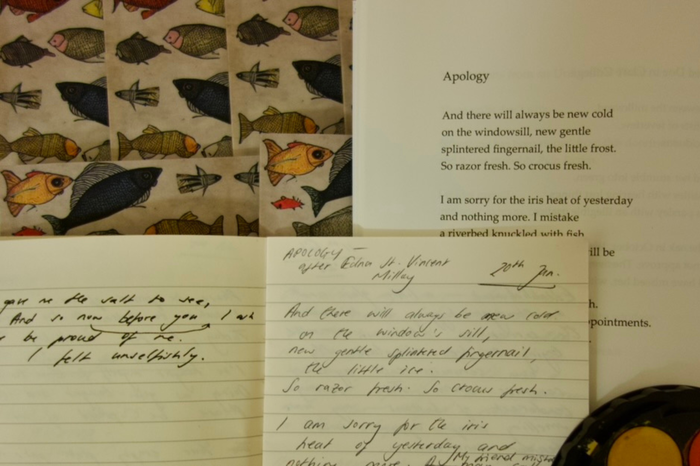Postscripts: ‘To Keep Things Tidy’
In the second edition of her column, Eve Connor speaks to student and poet Ahana Banerji about, prose, envelopes and keeping things tidy

To Keep Things Tidy- Ahana Banerji
When they interviewed you, you said your grandmother’s hair was the most difficult to fold into an envelope. Yes, you had to practice, you said, laughing modestly. When you started, you crumpled all our printer paper in an hour. But soon, you were confident folding walls – they were easy shapes and smooth enough to keep in your back pocket. Then, you progressed to potato peels, the backs of clocks.
Twirling the end of her plait around her index finger, your grandmother listened to you apologise as you shaved your head and then mine. There’s a wardrobe filled with envelopes made from our hair, unsent and unseen, misshapen and fingernailed through.
You cut your grandmother’s hair three days before she died. She watched you, caressed my lovely buzzcut. There’s a knack to holding hair as a singular thing. This, you repeated to the interviewer, who reaches to touch the envelope of your grandmother’s hair.
Not without gloves. The oil from his palm would damage it. But not from yours? No, not that way. What was the point, he asks, as the cameraman zooms in on your fingers. They catch you smiling. I am happy for what you learned from us.
You described this piece as ‘prose’ in your submission. I know you have written many brilliant poems. How porous do you find the boundary between the two forms?
I think intention has a lot to do with it. I have to wear my prose-tinted-glasses! I considered the possibility that ‘To Keep Things Tidy’ was a prose poem – something between the two – but it felt a bit wrong. When I wrote this, I wanted to write prose – so it is. Of course, the subjectivity of that falls apart quite easily. But that’s the fun of being a poet who writes prose – it is very porous – flitting between the two, but at the same time the distinction is very important to me.
Another format, the interview, pokes at me as I prep these questions. What led you to that frame?
I wanted to write about distance, and from a distance, I think. I spent a long time editing, clarifying the perspectives and the positions that each character inhabits in this piece. Lots of tricky origami-ish layers all scrunched up together in this one moment – someone watching someone they loved on TV, talking about something that is at once nothing and everything to do with them. And it’s also a little bit funny – the idea of an artist on a talk show, showing off a hairy envelope, and being asked a lot of questions about it. Grief can be funny that way too, I think, so I found the talk show format a good access point to expressing some of that intensity and weirdness.
“Lots of tricky origami-ish layers all scrunched up together in this one moment”
Let’s talk envelopes.
Yes! Actually, my mum and I were talking recently about how difficult we find it to throw away handwritten envelopes. There’s something in seeing your name written in someone else’s handwriting – again, there’s an intentionality. No one else will write my name in the same way again. And it’s an important visual reminder to me, that even envelopes – these things that are often scrappy, tucked away, and don’t really say anything – hold a lot of intimacy.
‘To Keep Things Tidy’ is, in both senses of the word, touching, and I remember, too, your rich details: ‘potato peels, the backs of clocks’ and ‘fingernailed through’. Is tactility important to your writing?
It’s a practice that started with poetry, for sure. When I was writing my poetry pamphlet, Piecemeal (Nine Pens Press), I found that the tactile touchstones were important for keeping everything from unravelling. I love tactility in prose writing – it’s what draws me to some of my favourite writers, like Anne Carson, Virginia Woolf, and Isabel Allende. I re-read Allende’s House of the Spirits at least once a year – her use of tactility creates a burrow between the past and the overwhelming present-ness of the narrative. It’s just brilliant, and everything I wish I could write.
Can art play a role in preservation?
Maybe. Even probably. There’s an instinct to answer this with a simple ‘yes’, but I guess it’s tricky when it comes to fiction – how can you preserve something that never existed? But I quite like the idea that there are some things that are simply lost in the art-making process – whether that’s just a quality or something more fundamental. Art can remind you of things, but it will never be the thing you’ve lost. Maybe it’s like an envelope – it holds an idea of the thing itself. I think it’s good to make things, even if it means losing something when you do.
If you’d like to have your writing featured in Eve’s column, please email your submission (s) with your name and college to socialmedia@varsity.co.uk – we are looking for poetry and micro fiction. Poetry should be max 20 lines, and micro fiction max 200 words. We look forward to reading your submissions!
 Features / Should I stay or should I go? Cambridge students and alumni reflect on how their memories stay with them15 December 2025
Features / Should I stay or should I go? Cambridge students and alumni reflect on how their memories stay with them15 December 2025 News / Cambridge study finds students learn better with notes than AI13 December 2025
News / Cambridge study finds students learn better with notes than AI13 December 2025 News / Uni Scout and Guide Club affirms trans inclusion 12 December 2025
News / Uni Scout and Guide Club affirms trans inclusion 12 December 2025 Comment / The magic of an eight-week term15 December 2025
Comment / The magic of an eight-week term15 December 2025 News / News In Brief: Michaelmas marriages, monogamous mammals, and messaging manipulation15 December 2025
News / News In Brief: Michaelmas marriages, monogamous mammals, and messaging manipulation15 December 2025








